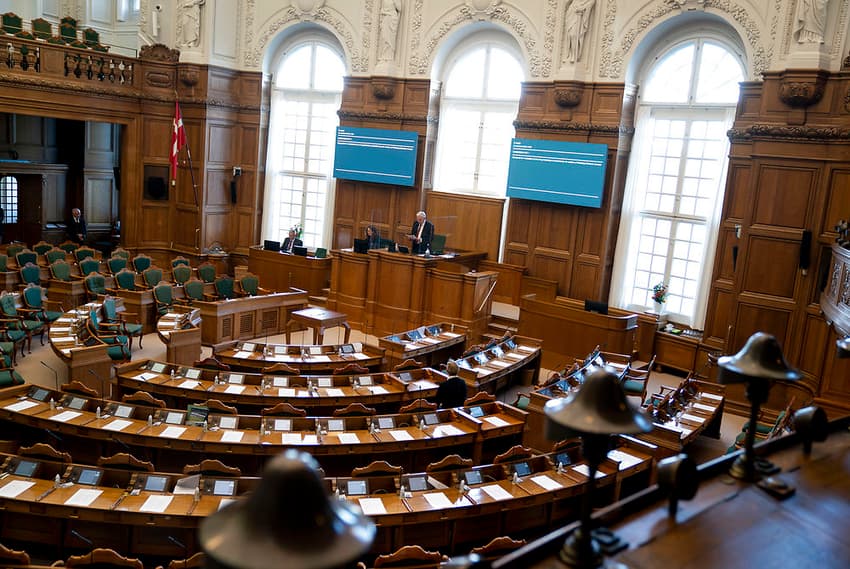Is Denmark’s parliament at the centre of a coronavirus outbreak?

An increasing number of Danish lawmakers, including several ministers and a party leader, have tested positive for coronavirus.
Editor's note: this article previously incorrectly stated five Danish ministers had tested positive for Covid-19. They were, in fact, in isolation after close contact to a confirmed case, but had not tested positive themselves. The error has been corrected.
In addition to a number of confirmed cases, several other elected politicians are now isolating due to close contact with the virus, according to reports by news wire Ritzau and broadcaster DR.
Members of parliament to been in isolation after close contact with a confirmed Covid-19 case in the last two days now include Social Democratic ministers Peter Hummelgaard (employment), Pernille Rosenkrantz-Theil (children and education), Ane Halsboe-Jørgensen (higher education and science), Lea Wermelin (environment) and Mogens Jensen (food). None have reported having symptoms.
Minister of Justice Nick Hækkerup is in home quarantine after experiencing symptoms and is awaiting a test result.
Another Social Democratic MP, Jeppe Bruus, has also tested positive for the virus.
Other party representatives have not been spared the apparent outbreak at the parliament.
Søren Pape Poulsen, the former justice minister who leads the Conservative party, has tested positive for Covid-19, his party confirmed on Tuesday. Fellow Conservative Egil Hulgaard has also been reported to have contracted the virus.
The most serious report regarding infected Danish politicians concerns Lars Christian Lilleholt of the Liberal (Venstre) party. Lilleholt, a former minister who is now the Liberal defence spokesperson, has been admitted to the University Hospital in Odense with pneumonia after testing positive for coronavirus and has been given the experimental treatment Remdesivir, he confirmed in a social media post.
A parliamentary questions session with Prime Minister Mette Frederiksen scheduled for Tuesday has been cancelled as a result of the outbreak.
Frederiksen has also confirmed, via a statement, that she and Hækkerup last week attended meetings with other lawmakers who have since tested positive for coronavirus.
Søren Pind, a former member of parliament with the Liberal party who left politics in 2018, suggested that parliamentary procedures should be adapted to prevent Covid-19 outbreaks.
“Perhaps – very carefully suggested – Parliament should rethink consultations and votes. Not by not having them. But the way they take place. Disease is every man’s master,” Pind wrote.
Det kunne godt være - meget forsigtigt foreslået - Folketinget skulle gentænke samråd og afstemninger. Ikke ikke at afholde dem. Men måden det foregår på. Sygdom er hver mands herre. https://t.co/OoW66hDhDj
— Søren Pind (@sorenpind) November 3, 2020
READ ALSO: Denmark's extended face mask requirement takes effect: These are the rules you need to know
Comments
See Also
Editor's note: this article previously incorrectly stated five Danish ministers had tested positive for Covid-19. They were, in fact, in isolation after close contact to a confirmed case, but had not tested positive themselves. The error has been corrected.
In addition to a number of confirmed cases, several other elected politicians are now isolating due to close contact with the virus, according to reports by news wire Ritzau and broadcaster DR.
Members of parliament to been in isolation after close contact with a confirmed Covid-19 case in the last two days now include Social Democratic ministers Peter Hummelgaard (employment), Pernille Rosenkrantz-Theil (children and education), Ane Halsboe-Jørgensen (higher education and science), Lea Wermelin (environment) and Mogens Jensen (food). None have reported having symptoms.
Minister of Justice Nick Hækkerup is in home quarantine after experiencing symptoms and is awaiting a test result.
Another Social Democratic MP, Jeppe Bruus, has also tested positive for the virus.
Other party representatives have not been spared the apparent outbreak at the parliament.
Søren Pape Poulsen, the former justice minister who leads the Conservative party, has tested positive for Covid-19, his party confirmed on Tuesday. Fellow Conservative Egil Hulgaard has also been reported to have contracted the virus.
The most serious report regarding infected Danish politicians concerns Lars Christian Lilleholt of the Liberal (Venstre) party. Lilleholt, a former minister who is now the Liberal defence spokesperson, has been admitted to the University Hospital in Odense with pneumonia after testing positive for coronavirus and has been given the experimental treatment Remdesivir, he confirmed in a social media post.
A parliamentary questions session with Prime Minister Mette Frederiksen scheduled for Tuesday has been cancelled as a result of the outbreak.
Frederiksen has also confirmed, via a statement, that she and Hækkerup last week attended meetings with other lawmakers who have since tested positive for coronavirus.
Søren Pind, a former member of parliament with the Liberal party who left politics in 2018, suggested that parliamentary procedures should be adapted to prevent Covid-19 outbreaks.
“Perhaps – very carefully suggested – Parliament should rethink consultations and votes. Not by not having them. But the way they take place. Disease is every man’s master,” Pind wrote.
Det kunne godt være - meget forsigtigt foreslået - Folketinget skulle gentænke samråd og afstemninger. Ikke ikke at afholde dem. Men måden det foregår på. Sygdom er hver mands herre. https://t.co/OoW66hDhDj
— Søren Pind (@sorenpind) November 3, 2020
READ ALSO: Denmark's extended face mask requirement takes effect: These are the rules you need to know
Join the conversation in our comments section below. Share your own views and experience and if you have a question or suggestion for our journalists then email us at [email protected].
Please keep comments civil, constructive and on topic – and make sure to read our terms of use before getting involved.
Please log in here to leave a comment.